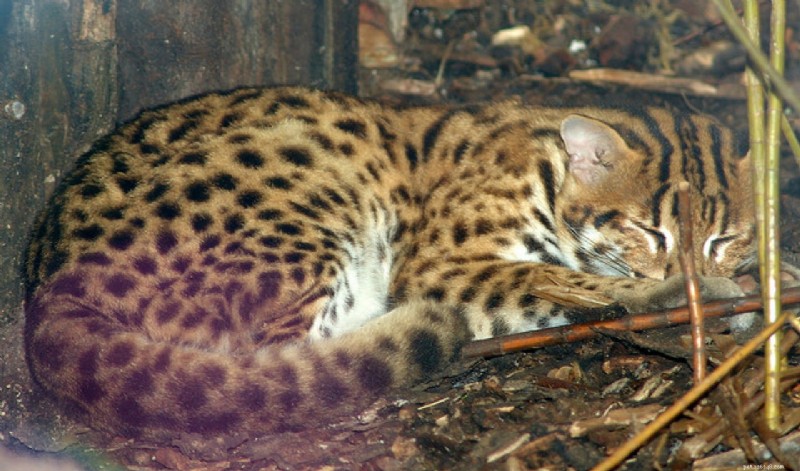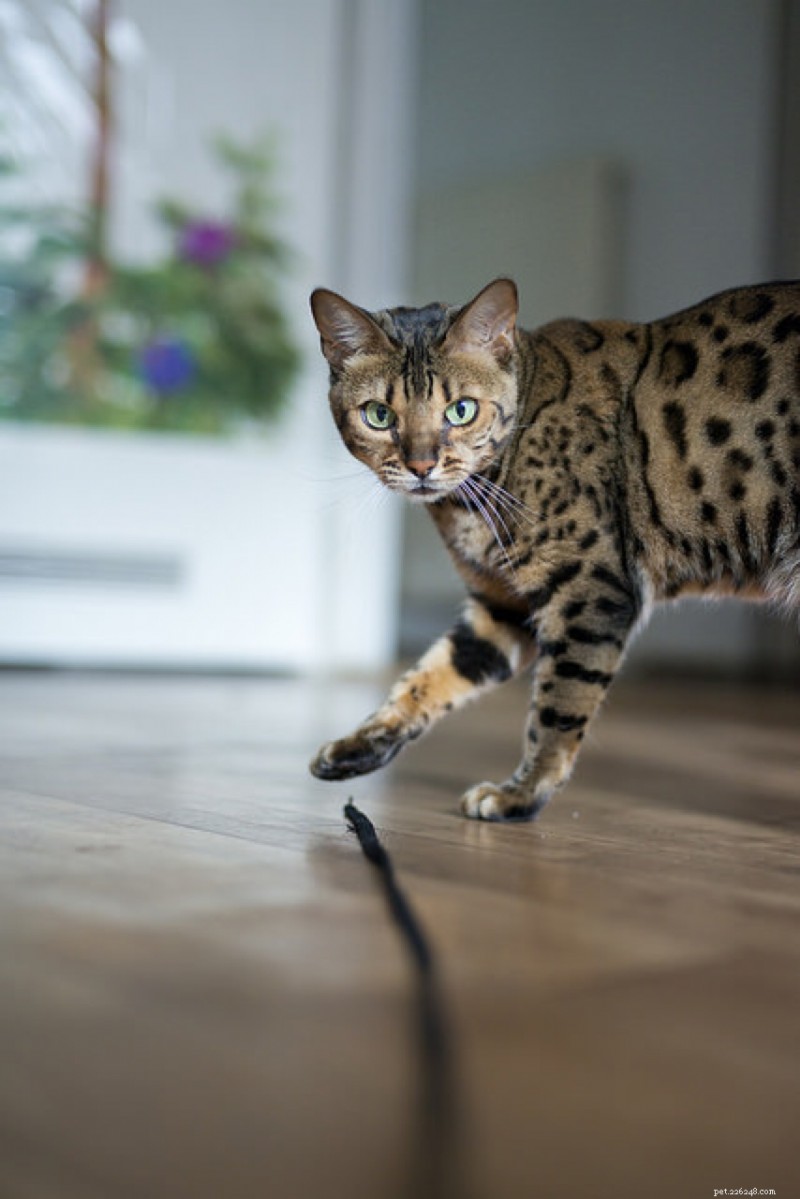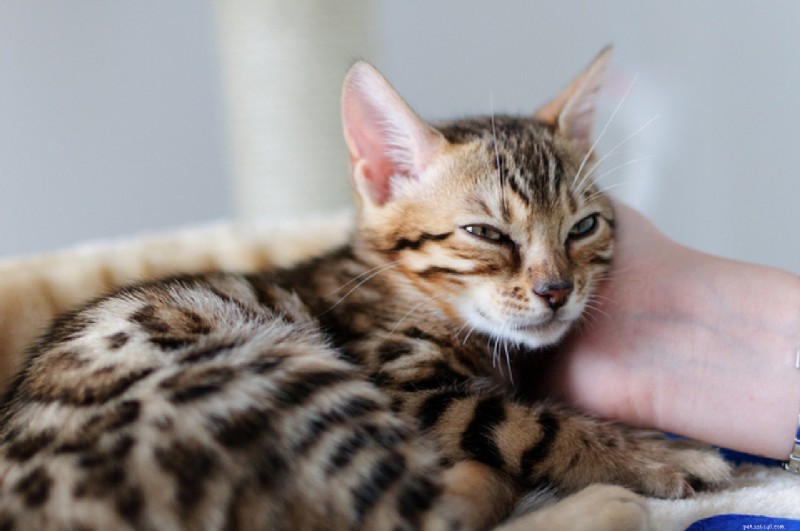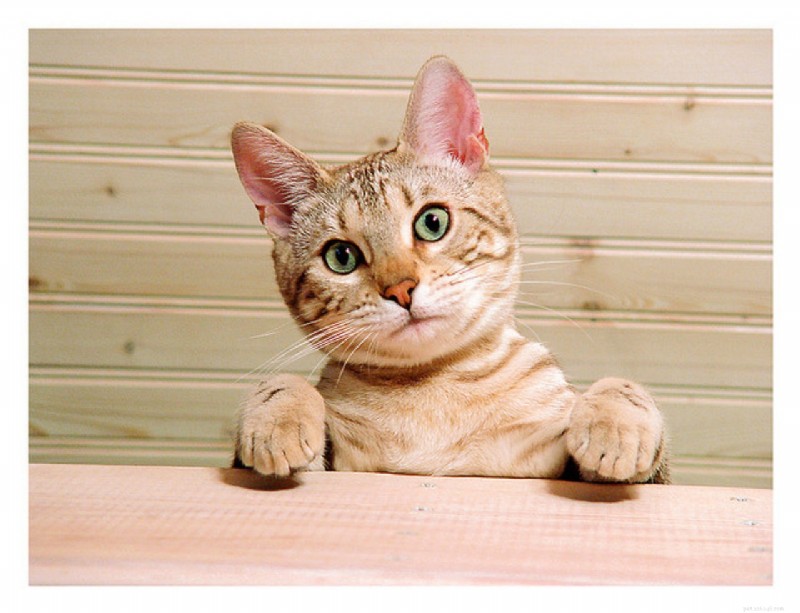
Cette magnifique race de chat hybride peut retracer son ADN à de vrais félins sauvages, à savoir le chat léopard asiatique. On l'appelle le chat du Bengale du nom latin de sa progéniture sauvage - Prionailurus bengalensis - bien que l'aire de répartition du chat léopard asiatique s'étende au-delà de la petite région du Bengale. Les passionnés de chats et les scientifiques sont fascinés par la création d'hybrides depuis la fin du 19e siècle, lorsque les expositions félines ont commencé à décoller. Tout au long des années 1930 et 1940, plusieurs tentatives de création du chat Bengal moderne ont été enregistrées, avec des résultats décevants.
Ce n'est qu'en 1963 que le premier chat Bengal est né de Jean S. Mill, le produit de son chat domestique mâle et d'un "chat léopard" qu'elle a acheté dans une animalerie. Kin Kin, comme elle a été nommée, a défié les attentes des scientifiques et a continué à produire une deuxième génération de Bengals. L'hybridation des chats a pris son essor dans les années 1970, en particulier après la découverte de l'immunité naturelle de certains chats sauvages contre des maladies comme le FIV et le FeLV. Jean S. Mill s'est recentré sur les chats du Bengale en 1980, en en achetant plusieurs pour les croiser avec un chat des rues ressemblant à un léopard qu'elle a trouvé en Inde.
Le chat Bengal a été accepté par l'International Cat Association (TICA) comme nouvelle race de chat en 1986, obtenant le statut de champion en 1991. Le spectacle d'aujourd'hui Les Bengals sont la cinquième génération depuis les félins originaux de Jean S. Mill, très éloignés de leurs racines sauvages. /P>
Personnalité et tempérament du chat Bengal

Bien qu'il soit important de se rappeler que chaque chat a sa propre personnalité, il existe certains traits que la plupart des Bengals ont généralement. La race est connue pour son caractère unique et est souvent décrite comme intelligente, curieuse et interactive. Les Bengals sont connus pour jouer à des jeux de base comme aller chercher ou à cache-cache, profiter de la récréation et des méfaits généraux. Ces vidéos de chats nageurs contiennent en grande partie des chats du Bengale, qui font des tours de chat dans une baignoire.
L'attachement aux humains est également une partie importante de la personnalité du Bengale. Si vous cherchez un compagnon constant, curieux de tout ce que vous faites, alors c'est la race qu'il vous faut ! «Les Bengals voudront aussi, en général, TOUJOURS être là où vous êtes. Après tout, c'est là que se passe l'action !" advises TICA. “And Bengals are all about ‘the action.'” Channel their high energy into mental stimulation, with puzzle toys, supervised outdoor visits or a catio, a birdhouse (to watch), or general hunt-based play with toys.
Bengal Breeders or Rescue?
Most pet parents looking for a specific breed of cat go straight to a breeder for their new fur baby. However, there are always breed-specific rescues that have plenty of felines who need furever homes. A quick Internet search for “Bengal rescue” shows organizations across the country (and world) dedicated to rehoming Bengal cats. Many Bengal rescues are regional, so even if the group isn’t based in your state, give them a call! If they can’t help you, ask if they know anyone in your area who can; the Bengal Rescue Network has affiliates in every corner of the country and even Canada.

However, if you do decide to go to a Bengal breeder, it’s important to ensure he or she is reputable and will provide you with a healthy pet. Besides your initial search, nothing should be conducted on the Internet! Always visit the breeder’s facilities and meet your pet-to-be in person before making any financial commitments. Ask to see other animals as well, and find out the daily routine – How much playtime do they get? When are they fed? Where do they sleep? For your future pet in particular, ask in-depth questions about personality, quirks, health, and even favorite toys or siblings. If a breeder is loving and professional, they should know the cat like their own pet – after all, they bring these “fur babies” into the world! Be wary of any breeders who want to ship an animal to you or will not provide you with a vet’s clean bill of health. Asking to meet you in a place besides your home or their facilities – say, a grocery store or parking lot – is also a red flag.
Marbled, Glitter, Silver and Snow Bengal Cats

While these may sound like items in a toddler’s craft kit, they’re actually Bengal coat colors and patterns! Most Bengals are varying shades of brown, according to Bengals Illustrated, the breed’s most popular magazine. “No matter what the color/tone, the pattern on a Bengal cat should yield a high degree of contrast,” the publication says. All-black Bengals, often called “pantherettes,” are unrecognized by the TICA for competition status, although many unaffiliated groups celebrate them. Long-haired Bengals have also been reported but are uncommon, the result of a recessive gene.
A marbled Bengal cat has more splotches and swirls than leopard-like spots, which can be reminiscent of a boa snake. The breed’s fur is noted for its excessive sheen, which often seems to glitter in direct light; flecks of gold or silver on the shaft of individual hairs gives the Bengal cat its shine. Sometimes mistaken for Egyptian Maus – whose facial structure, markings and body shape are much different – the silver Bengal is a relatively newcomer to the breed; true silvers have no yellow undertones, and pewter to black spots.
Although generally referred to as the white or snow Bengal cat, there are technically several patterns with a white base coat. Seal Lynx Points, Seal Minks, and Seal Sepias show a spectrum of contrasting colors – all have a coat color described as “creamy” white, not pure. Snow Bengals can have gorgeous green, blue or copper eyes, and coat patterns often develop as a kitten ages.
(Featured image via Wikimedia Commons)